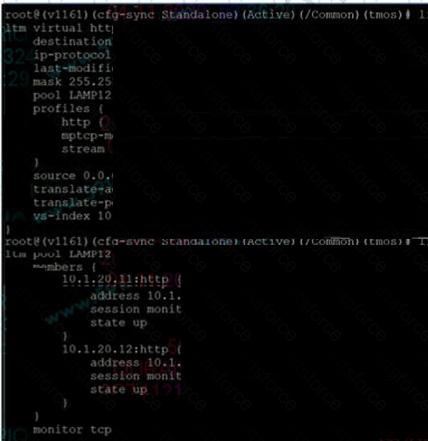A BIG-IP Administrator upgrades the BIG-IP LTM to a newer software version. After the administrator reboots into the new volume, the Configuration fails to load. Why is the Configuration failing to load?
A BIG-IP has two load balancing virtual servers at 150.150.10.10:80 and 150.150.10.10:443. The port 80 virtual server has SNAT automap configured. There is also a SNAT configured at 150.150.10.11 set for a source
address range of 200.200.1.0 / 255.255.255.0. All other settings are at their default states. If a client with the IP address 200.200.1.1 sends a request to https://150.150.10.10, what is the source IP address when the
associated packet is sent to the pool member?
Refer to the exhibit.

A BIG-IP Administrator creates a new Virtual Server. The end user is unable to access the page. During
troubleshooting, the administrator learns that the connection between the BIG-IP system and server is
NOT set up correctly.
What should the administrator do to solve this issue?
A BIG-IP Administrator configures a Virtual Server. Users report that they always receive a TCP RST packet to the BIG-IP system when attempting to connect to it. What is the possible reason for this issue?
Refer to the exhibit.

Due to a change in application requirements, a BIG-IP Administrator needs to modify the configuration of a Virtual Server to include a Fallback Persistence Profile.
Which persistence profile type should the BIG-IP Administrator use for this purpose?
Users report that traffic is negatively affected every time a BIG-IP device fails over. The traffic becomes
stabilized after a few minutes.
What should the BIG-IP Administrator do to reduce the impact of future failovers?
Which three methods can be used for initial access to a BIG-IP system? (Choose three.)
An LTM device has a virtual server mapped to www5f.com with a pool assigned. The objects are defined
as follows:
Virtual server. Destination 192.168.245.100.443 netmask 255.255.255.0
Persistence: Source address persistence netmask 255.0.0.0
SNAT:AutoMap
Profiles: HnP/TCP
How should the BIG-IP Administrator modify the persistence profile so that each unique IP address
creates a persistence record?

A BIG-IP Administrator notices that one of the servers that runs an application is NOT receiving any traffic. The BIG-IP Administrator examines the configuration status of the application and observes the displayed monitor configuration and affected Pool Member status. What is the possible cause of this issue?
A BIG-IP Administrator needs to configure the BIG-IP system to perform load balancing for FTP servers
running passive mode FTP.
How should the administrator configure the Virtual Server to perform this load balancing?